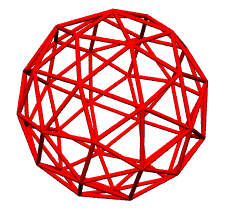On the Omnidirectional Halo
Synergetics is a geometric vision pumped full of as much significance
as possible. Getting all experiences to mean something in terms of geometry
might seem undoable at first, but the tack is to get a view of thinking
itself, to present the thinking process in terms of a geometric model.
By thinking about thinking in terms of geometry, all thought content is
thereby brought within its scope.
The synergetics model of thinking is derived by analogy to the electromagnetic spectrum. It helps that we already have a vernacular wherein like-minded people are "on the same wavelength" and wherein ideas get "tuned in". In synergetics, the brain is the metaphorical "TV transceiver" wherein sense-relayed programs are presented to experience.
![]()
The electromagnetic spectrum as traditionally depicted in text books is a linear affair, from shortest to longest wavelengths. Synergetics depicts this continuum of shortest to longest as concentric spherical networks, the way we have been taught to view electrons (the ones in s-orbitals at any rate). The highest frequency systems (e.g. gamma particles) are towards the center, whereas larger scale phenomena (e.g. the portion of the spectrum visible to the naked eye) occupy middle to outer layers of the spectral onion.
To think, then, is to highlight one spherical band within the continuum, to select a channel. Higher and lower bands are "dismissed as irrelevant" because, relative to the tuned-in system, these higher and lower frequency bands are too close together, or too far apart to merit close attention.
